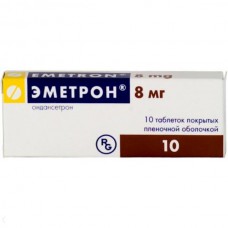Expiration date: 11/2026
The composition and form of issue:
Solution for injection 1 amp.
ondansetron (as hydrochloride dihydrate) 4 mg
8 mg
excipients: citric acid monohydrate trinacria citrate sorbitol water for injection
in ampoules of 2 or 4 ml in a box 5 ampoules.
Tablets, film-coated 1 tab.
ondansetron (as hydrochloride dihydrate) 4 mg
8 mg
excipients: silica colloidal anhydrous magnesium stearate talc starch pregelatinization MCC corn starch lactose anhydrous, iron oxide yellow titanium dioxide macrogol 6000 Sepifilm 003 (hydroxypropyl methylcellulose + polyxystra)
in a contour acheikova packing 10 PCs in 1 box packing.
Description pharmaceutical form:
Tablets, film-coated 4 mg: biconvex, film-coated, a characteristic yellow color, engraved "4" on one side and "RG" on the other.
Tablets, film-coated 8 mg: biconvex, film-coated, a characteristic yellow color, engraved "8" on one side and "RG" on the other.
Solution for injection 4 mg 2 ml 8 mg 4 ml: clear, colourless or almost colourless solution without mechanical inclusions.
Pharmacological action:
Selectively blocks the serotonin 5-HT3-receptor neurons of the Central and peripheral nervous system.
Pharmacokinetics:
Ingestion Cmax achieved after 1.5 h, when the/m after 10 min. the protein Binding is 70 to 76%. The oral bioavailability is around 60%. Metabolized in the liver. T1/2 about 3 hours in elderly patients — up to 5 h, when severe liver disease is 15-20 hrs, return with urine (unchanged to less than 5%).
Description pharmacological action:
Slow development gag reflex that prevents and eliminates nausea and vomiting, indirect release serotonin under the influence of drugs, General anesthetics (postoperative period) and radiation therapy.
Indications:
Nausea and vomiting (prevention and treatment) on the background of cytotoxic chemotherapy, radiation therapy, in the postoperative period.
Contraindications:
Hypersensitivity, breast-feeding.
Application of pregnancy and breast-feeding:
During pregnancy (especially in I trimester) is possible only if the expected effect therapy outweighs the potential risk to the fetus. At the time of treatment should stop breastfeeding.
Side effects:
Headache, flushing, sensation of heat, constipation, transient increase of aminotransferases in rare cases — dizziness (with the rapid on/in the introduction), cough, impaired visual acuity, motor disorders, convulsions, arrhythmia, bradycardia, chest pain, hypotension, hiccup, diarrhea/constipation, hypersensitivity reactions (including anaphylaxis).
Drug interactions:
Inducers or inhibitors of cytochrome P450 can change the clearance and T1/2.
Method of application and dose:
In/in, in/m, inside.
Cytotoxic therapy
The choice of dosage regimen is determined by the severity emetogenic actions carried out by anti-cancer therapies.
Daily dose for adults is usually 8-32 mg.
At a moderate emetogenna chemotherapy or radiotherapy:
- 8 mg/bolus or slow/m, just before the beginning of therapy
8 mg inside for 1-2 hours before treatment, then 8 mg orally 12 hours after the start of therapy.
In case of high emetogenic chemotherapy:
8 mg in/in struino (slowly) immediately before the start of chemotherapy, and then two more in bolus injection of 8 mg, each of which is 2-4 hours
- continuous 24-hour infusion at a dose of 24 mg at a rate of 1 mg/h
- 16-32 mg diluted in 50-100 ml of an appropriate infusion solution, in the form of 15-minute infusion directly before the start of chemotherapy.
The effectiveness of ondansetron can be enhanced by a single on/in the introduction of glucocorticoid (e.g. 20 mg of dexamethasone) before beginning of chemotherapy when administered to enhance the effect the dose can be increased to 24 mg and appointed simultaneously with 12 mg of dexamethasone for 1-2 hours before start of chemotherapy.
For the prevention of delayed emesis occurring 24 h after the start of chemotherapy or radiotherapy, it is recommended to continue drug use inside of 8 mg 2 times a day for 5 days.
Children older than two years the drug is administered in a dose of 5 mg/m2 body surface/V, immediately before chemotherapy, followed by administration of an oral dose of 4 mg over 12 h after the end of chemotherapy is recommended to continue treatment for 4 mg 2 times a day orally for 5 days.
Prevention of postoperative nausea and vomiting
Adults administered single dose of 4 mg in/m or/in struino slowly at the beginning of anesthesia, or prescribe 16 mg orally 1 h before anesthesia.
Incurred for the relief of nausea and vomiting the recommended/m or slow I/introduction 4 mg.
I/m in the same part of the body of ondansetron may be administered at a dose not exceeding 4 mg!
Children to prevent postoperative nausea and vomiting, ondansetron is used exclusively parenterally in a single dose of 0.1 mg/kg (maximum 4 mg) by slow intravenous injection during or after anesthesia.
Developed for the treatment of postoperative nausea and vomiting in children is recommended to slow in/in the introduction of a single dose of 0.1 mg/kg (maximum 4 mg).
With regard to the prevention and treatment of postoperative nausea and vomiting in children under 2 years not enough experience.
Elderly patients, changes dosage not required.
Patients with lesions of the liver and kidney: in kidney to change the usual daily dose and frequency of drug administration is not required when liver disease substantially reduces the clearance of ondansetron, and increases the half-life time of it from plasma, so do not exceed the daily dose (8 mg).
Dilution of injection solution may include the following solutions: 0.9% sodium chloride solution, 5% dextrose solution, ringer solution, 0.3% solution of potassium chloride and 0.9% sodium chloride solution, 0.3% solution of potassium chloride and 5% dextrose solution.
Precautions:
Need a special observation of patients with signs of subacute bowel obstruction (because of the time passing through the colon).
Special instructions:
Do not impose one sprite with other drugs. Injectable form diluted immediately prior to use, and only recommended solutions (solutions of sodium and potassium chloride, glucose, mannitol, ringer's). Do not autoclave ampoules.



